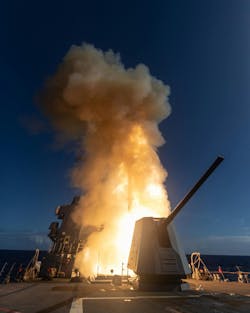RTX Raytheon to build ship- and land-based missile-defense smart munitions with electro-optical guidance
DAHLGREN, Va. – RTX Corp. will build ship- and land-based smart munitions to acquire, track, and destroy incoming ballistic missiles under terms of an $1.9 billion contract announced Thursday.
Officials of the U.S. Missile Defense Agency in Dahlgren, Va., are asking the RTX Raytheon segment in Tucson, Ariz., to manufacture and assemble RIM-161 Standard Missile-3 Block IIA missiles for the U.S. military and the government of Japan.
The Standard Missile-3 is a Navy hit-to-kill ballistic missile-defense interceptor designed to destroy short-to-intermediate-range ballistic missiles. It uses an exoatmospheric kill vehicle that crashes into the incoming ballistic missile target during its mid-course phase in space.
The Standard Missile-3 Block IIA interceptor guidance system has a kill vehicle with solid throttling divert and attitude control system, upgraded communications, and an improved two-color electro-optical guidance seeker. Measuring 21.5 feet long and 21 inches in diameter, the missile is about the size of a telephone pole.
The Block IIA seeker has more than double the sensitivity and more than three times the divert capability of the Block IB, MDA officials say. Its sensitivity and ability to communicate with the ground enable the IIA interceptors to act as additional sensors to help other interceptors discriminate between real inbound ballistic missile warheads and decoys.
The massive collision of the kill vehicle hitting its target obliterates the incoming ballistic missile and its warheads; explosives are not necessary. The resulting impact is the equivalent of a 10-ton truck traveling at 600 miles per hour.
Related: Electro-optical sensors key to missile defense
The Standard Missile-3 launches from the U.S. Navy Vertical Launch System (VLS) aboard Navy destroyers and cruisers, as well as from and Aegis Ashore sites. The missile has upgraded steering and propulsion capability that uses short bursts of precision propulsion to direct the missile toward incoming targets.
Raytheon is building the next-generation Standard Missile-3 Block IIA in cooperation with Japan for deployment on land and at sea. It has two distinct features: large rocket motors that will enable it to defend broad areas from ballistic missile threats and a large kinetic warhead.
On this contract Raytheon will do the work in Tucson, Ariz.; and Huntsville, Ala., and should be finished by February 2031. For more information contact RTX Raytheon online at www.rtx.com/raytheon, or the Missile Defense Agency at www.mda.mil.
About the Author
John Keller
Editor-in-Chief
John Keller is the Editor-in-Chief, Military & Aerospace Electronics Magazine--provides extensive coverage and analysis of enabling electronics and optoelectronic technologies in military, space and commercial aviation applications. John has been a member of the Military & Aerospace Electronics staff since 1989 and chief editor since 1995.
